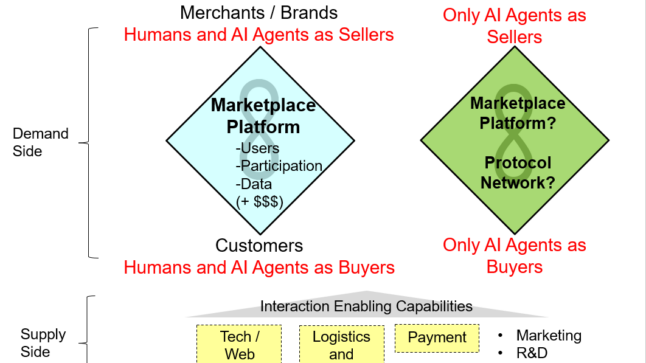In Part 2, I outlined Alibaba’s current GenAI strategy.
And that is a pretty common approach to AI right now, which I call AI Strategy 1.0.
But I really want to focus on what comes next, which I call AI Strategy 2.0.
And this means watching for three new business models that are emerging. And Alibaba is definitely making moves here.
Alibaba’s New DingTalk AI Assistant is an Example of an “AI Service Pipeline”
Alibaba has announced their new DingTalk AI Assistant. And this is pretty exciting.
Basically, they are embedding their multimodal foundation models into DingTalk, which is their competitor to WeChat. Although with more of an enterprise focus.
I think they are going to fundamentally change DingTalk from mostly an enterprise messenger and collaboration tool (think Slack) into a full AI agent. It’s going to become something totally new.
AI Agents are a big deal. And they are a powerful example of a new type of AI-first business model. I call this an “AI Service Pipeline”.
We talk a lot about platform business models. But most businesses are linear business models. Sometimes called pipelines. The inputs go in (like materials into a factory). Each step adds value. And the final product goes out. It’s a linear process of value creation, that sits within an industry also based on a linear process.
Which looks like this.
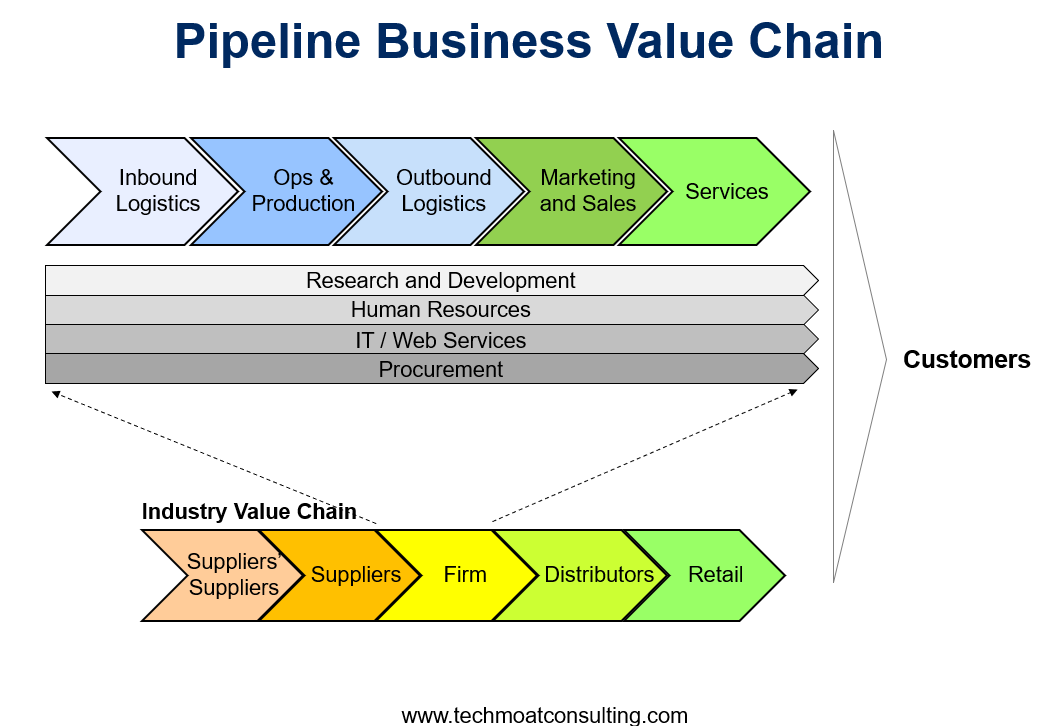
This is Michael Porter 101. His well-known value chains, which were mostly talking about physical goods and services.
However, digital goods and services (such as software) changed this. They made it very easy to connect with other complementary digital goods and services. Suddenly, you could create a more powerful and complete solution for customers. Michael Porter has since updated his 5 Forces framework to include complements as the 6th Force.
That looks like this. Like half of all digital innovation has been creating a new digital service that is super popular. And then building a ton of complementary services around that captured point in the value chain.
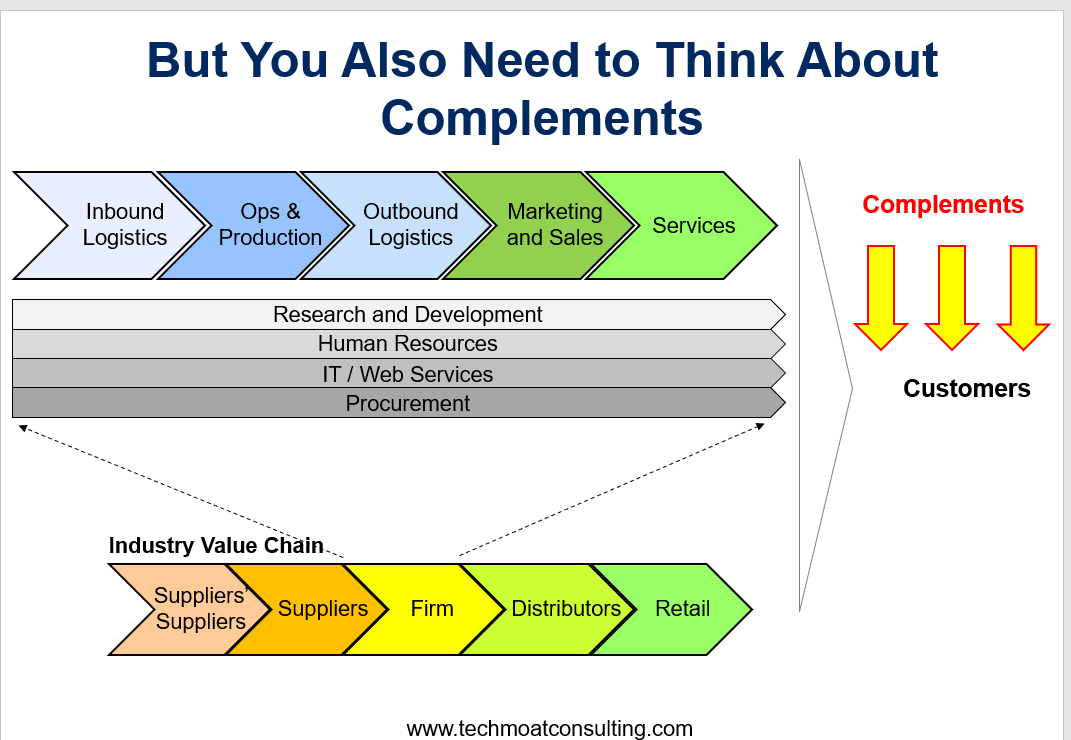
It now looks like generative AI is changing this model again.
A linear business model (i.e., a pipeline) based on a generative AI service has very different characteristics than a pipeline for physical goods and services. And for standard digital goods and services.
Take robotaxis as an example.
- Robotaxis are AI agents moving around in the real world. And they show increasing intelligence with customers and usage. They know the roads better. They avoid accidents better. We don’t’ see that in traditional software.
- Robotaxis are also connected. They are connected both to other robotaxis. They see what the others see. They know what the others now. They can coordinate movement. They can also connect and coordinate with smart infrastructure such as streetlights, roads, and parking lots. And they can be connected to other complementary services (reserve a parking space).
These business models are clearly something new. I call them “AI Service Pipelines”. They look like this.
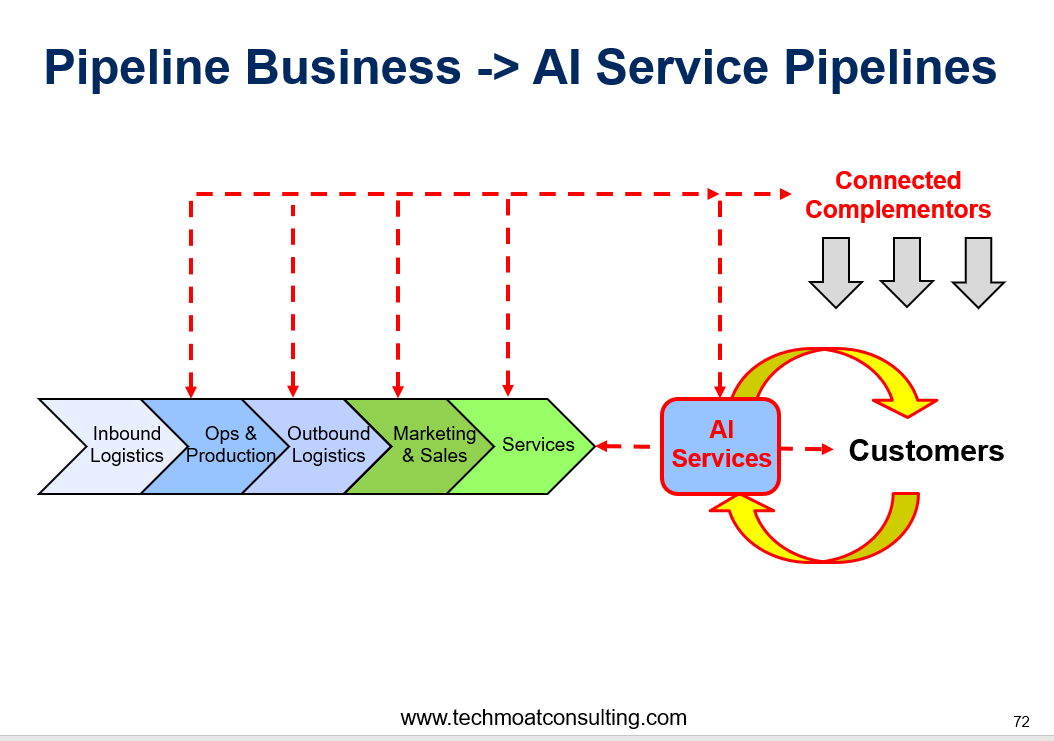
This is one of three new GenAI business models I am now watching for. I have added them to my list of 9 digital business models.
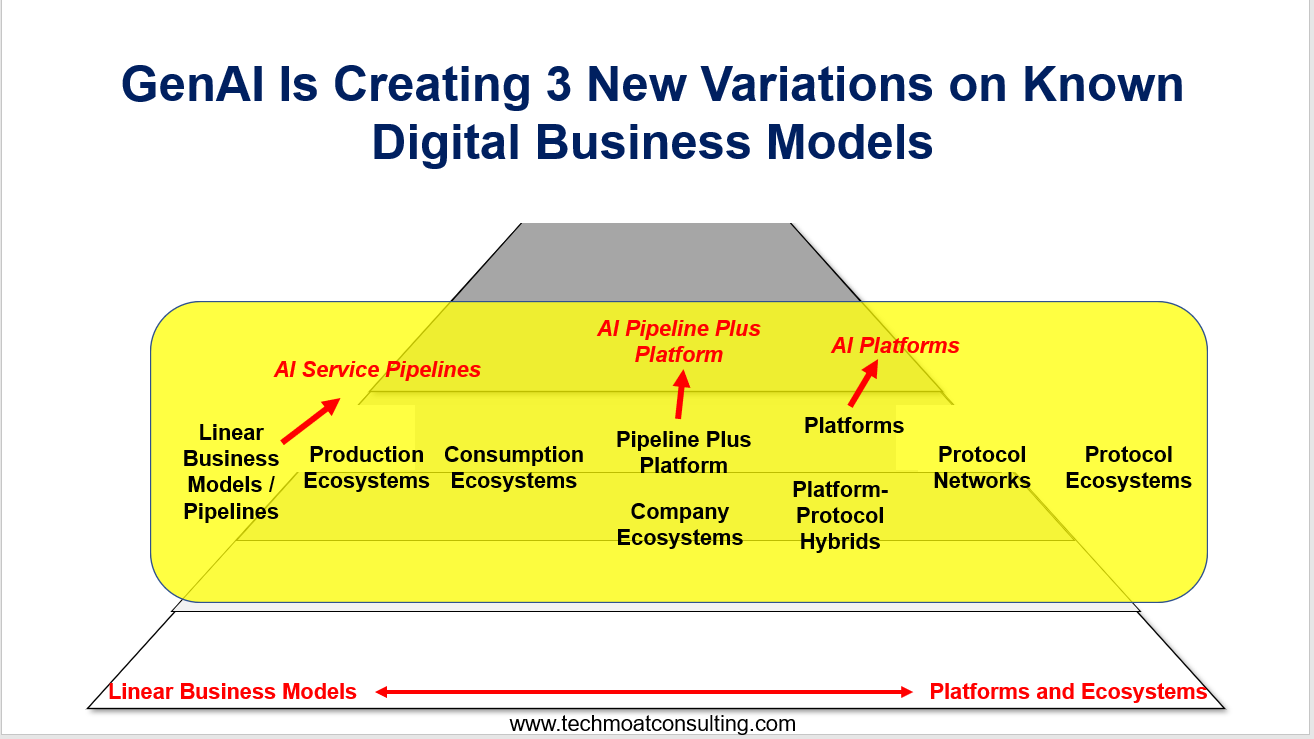
Ok, back to Alibaba’s new DingTalk AI Assistant.
Think about what this DingTalk AI Assistant should be able to do (one day).
Personal AI Agents:
Personal AI agents are pretty easy to understand. It could be your personal assistant, who you can chat with and order to do basic tasks. It could answer your questions, pay your bills, and respond to your emails. Personal AI Agents could be your lawyer or your tax preparer. They could be your travel planner. Your school tutor. Maybe just a funny friend? Maybe a girlfriend or boyfriend?
My model for this is how billionaires live. The ones I have worked for all have multiple personal assistants. Almost like a royal court. They have people for every aspect of life. The have someone to tutor their kids. They have someone to arrange their vacations. They have various specialists to answer questions. And so. AI Agents will probably make this approach to life affordable for most everyone.
AI Agents in Companies:
This is a really big idea. AI agents could do a lot of the support functions (claims processing, maintenance checks, security, etc.) at businesses. They could increasingly take over more advanced functions like accounting and law.
But the big idea is that they could become a big part of the workforce of the business. The workforce could be 50% human and 50% AI Agents. Maybe more. There is a new idea of whether you could build a billion-dollar company with no human employees. We’ll see.
AI Agents in Society:
And, of course, you can put AI agents into robots. That’s how you get robotaxis. And cleaning robots on the streets. And likely military drones and police. We should see lots of these AI agents roaming the streets, shopping malls and offices soon.
So, the DingTalk AI Assistant is Alibaba’s first big move into this space. And, given their tech depth, they are well positioned to succeed.
That’s cool. I think it’s a big deal. And it’s a good example of AI Service Pipelines as a business model.
***
Alibaba has also announced a new AI Agent Marketplace. This is Alibaba so, of course, they could not resist building a platform business model.
This new AI Agent Marketplace will let individuals and companies access lots of different AI agents. Think Upwork and Fiverr, but for AI agents instead of human workers. We’ll see. You should definitely, keep an eye on Ye Jun, who is the President of DingTalk.
And their DingTalk AI Assistant would complement this AI Agent Marketplace.
That is an important combination, which is the second business model. When a platform is complemented by an AI service, I call it an “AI Pipeline Plus Platform”.
“AI Pipeline Plus Platform” Business Models Have Already Appeared
The first big AI Service Pipeline business was ChatGPT. It was stunning. It definitely had some network effects and a growth flywheel. But I mostly don’t think about it as a platform. It is just a very powerful linear business model.
And ChatGPT was a shock to Google Search. And to Bing. And to all the search engines. They rightfully saw this new AI service as a massive substitute. If you got the answer from ChatGPT, you didn’t need the search results.
So, they all rushed to create their own versions, which they now offer as complements to their search engines.
Do a search on Google or Bing today. You will get a search engine result right next to an LLM answer by Copilot or Gemini. I call this combination an “AI Pipeline Plus Platform”.
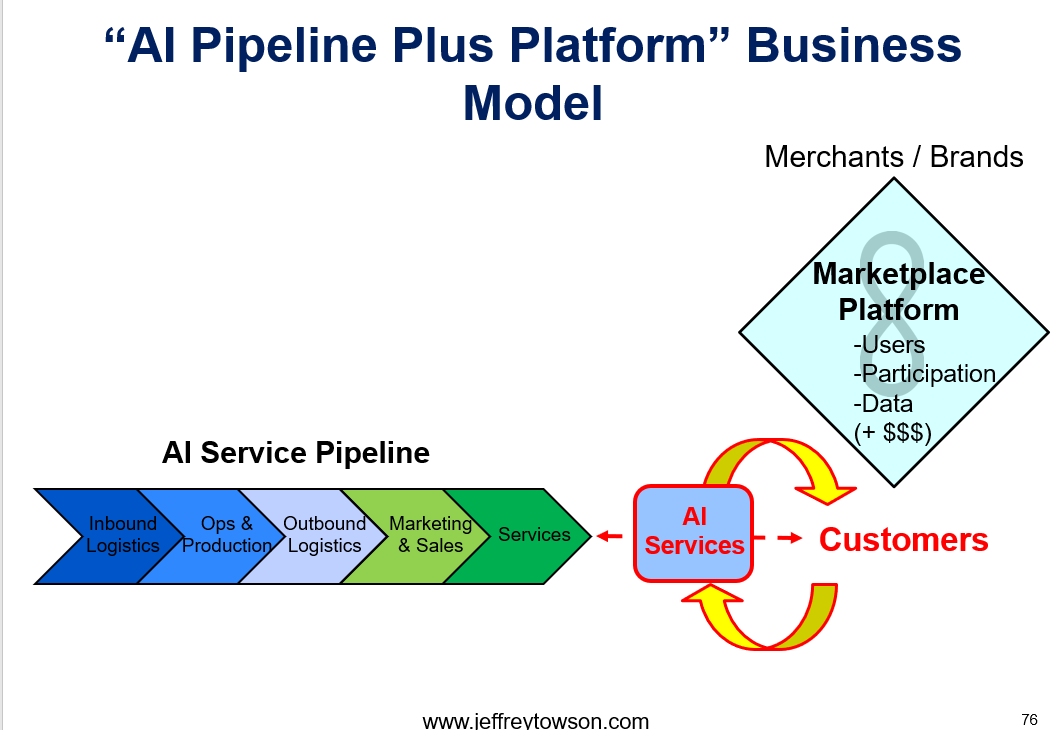
Note: Isn’t this graphic what DingTalk is building? An AI Assistant paired with an AI Agent marketplace.
We can already see this business model coming at ridesharing companies like Uber, Grab and Didi. They know robotaxis are coming. They can see Tesla and Baidu already putting them on the streets (especially Baidu). And just like ChatGPT, these AI services will be direct substitutes for their marketplace platforms.
We should expect to see robotaxis paired with ride-sharing marketplaces. When you look for a ride, you will get to choose between a human driver or a robotaxi. Just like you now get two answers on Google Search.
I’ve also speculated that we will see the same thing in video and other types of content creation.
Platforms like Instagram, TikTok and YouTube are all about matching viewers with content created by humans. But it’s likely generative AI is going to be able to create on its own content (without humans).
- Do you want to want to watch a travel video for Bali by travel vlogger? YouTube will show you a list of videos to watch.
- Or would you like for the AI service to generate a personalized video just for you on this topic?
I think YouTube, TikTok and other audience builder platforms will have to add complementary AI services to their offerings. We’ll see.

Last Point: Get Ready for “AI Platforms”
GenAI is giving powerful new tools to humans. Especially in content creation. These can be copilots of autopilots. They can be human creating content using AI tools (i.e., copilots). Or they can be AI Agents that create the content on their own (i.e., autopilots).
I have argued that platform business models are increasingly going to connect humans consuming content with other humans using GenAI to create content (i.e., copilot). But they are going to connect with AI agents creating content (i.e., autopilot).
You can watch videos created by humans (with AI tools) on YouTube. Or you can watch videos created and posted by AI agents. That’s the next evolution of platform business models.
And we will see the same thing on the supply side of lots of platform business models. On product marketplaces (like Taobao), we should see products being sold by humans (individually or at companies) and also by AI agents.
We should also expect to see AI Agents beginning to act as buyers on these marketplaces. If I don’t want to look for new socks on Taobao, I can just tell my AI agent to go get me some socks. It will go on Taobao as a buyer and do the transaction.
We should see marketplaces (like Taobao) evolve into platforms where both humans and AI agents are acting as buyers and sellers. I call these “AI Platforms”.
It looks like the blue diagram below.
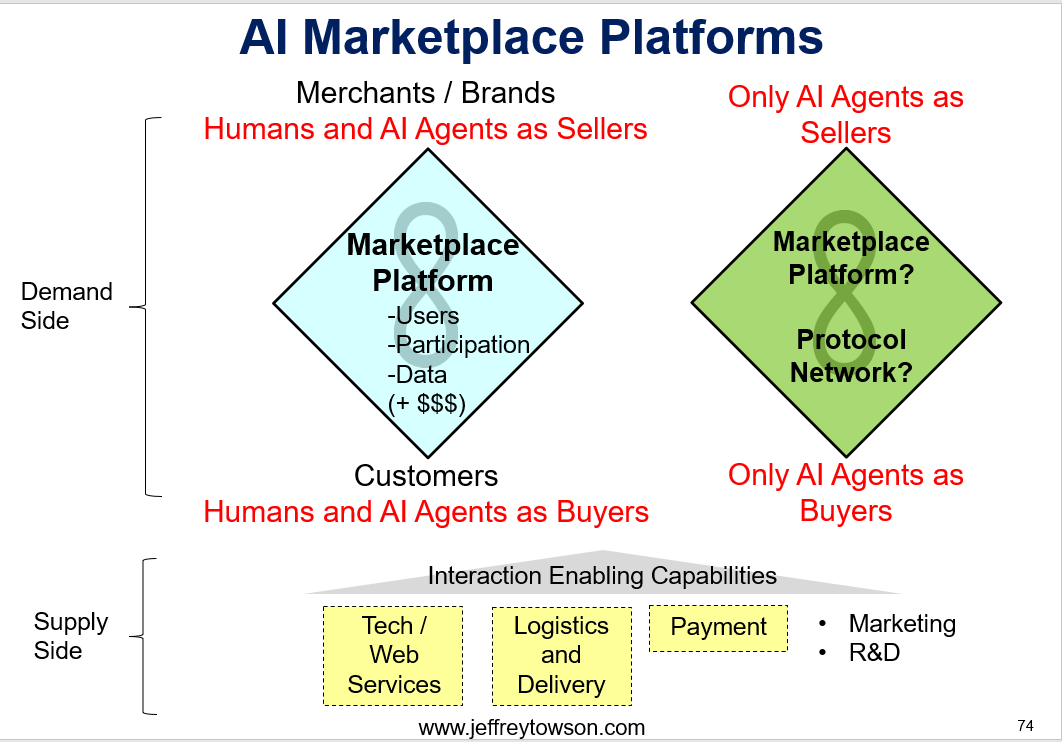
Now take a look at the green diamond on the right. This is more of a question.
Are we going to see marketplaces that are only for AI agents acting as buyers and sellers?
That will be weird.
If there are no humans on the marketplace (as buyers or sellers), do we really need a user interface at all? You just need software to connect with other software.
In that case, do we even need a platform business model?
Keep in mind, platforms are about aggregating demand and supply so humans can interact and match more efficiently. We need to see a list of options in one place. Platform business models are about lowering transaction and coordination costs for humans.
But does software need that?
Can’t AI Agents act as buyers and sellers very efficiently just by hunting a connected ecosystem? Do you need to aggregate on a platform? Or do you just need a standard protocol for interfacing? AI Agents may not have significant coordination costs. They may be closer to protocol networks.
Anyways, that’s just a question.
***
There are three new business models to watch for. Here’s the evolution I expect.
- Ecommerce companies (including marketplaces like Taobao and Tmall) will add AI-empowered services and capabilities to their suite of offerings. Alibaba is doing this right now. I call these “AI Service Pipelines”. They are linear business models but with different characteristics.
- Marketplace platforms will increasingly be complemented by AI services. I call these combinations “AI Pipelines Plus Platforms”.
- Platforms will start to have AI agents acting as sellers. And then as buyers. I call these platforms for humans and AI agents “AI Platforms”.
- We will probably start to see AI Agent only platforms (with no humans). I don’t have a name for this yet.
That’s it for today.
Cheers, Jeff

——–
Related articles:
- A Breakdown of the Verisign Business Model (2 of 2) (Tech Strategy – Daily Article)
- 3 Factors Will Determine the Future of Verisign Inc. (Tech Strategy – Podcast 191)
- A Strategy Breakdown of Arm Holdings (1 of 3) (Tech Strategy – Daily Article)
From the Concept Library, concepts for this article are:
- Cloud Services
- Generative AI
- AI Platform Business Model
- AI Pipeline and Platform Business Model
- AI Service Pipeline Business Model
From the Company Library, companies for this article are:
- Alibaba
- DingTalk AI Assistant
- Tmall and Taobao
- Alibaba Cloud
————
I am a consultant and keynote speaker on how to increase digital growth and strengthen digital AI moats.
I am the founder of TechMoat Consulting, a consulting firm specialized in how to increase digital growth and strengthen digital AI moats. Get in touch here.
I write about digital growth and digital AI strategy. With 3 best selling books and +2.9M followers on LinkedIn. You can read my writing at the free email below.
Or read my Moats and Marathons book series, a framework for building and measuring competitive advantages in digital businesses.
This content (articles, podcasts, website info) is not investment, legal or tax advice. The information and opinions from me and any guests may be incorrect. The numbers and information may be wrong. The views expressed may no longer be relevant or accurate. This is not investment advice. Investing is risky. Do your own research.
